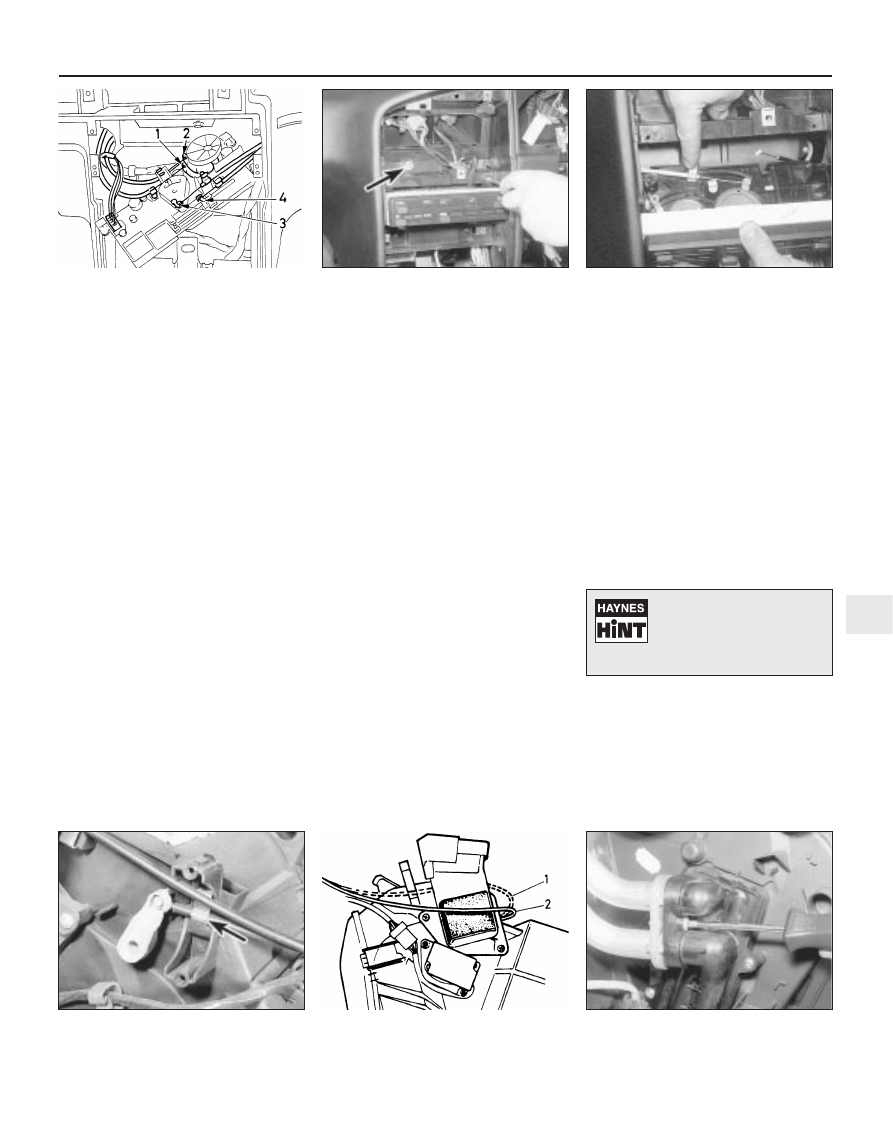содержание .. 26 27 28 29 ..
Peugeot 405. Manual - part 28

Heater/ventilation control unit -
models from 1993
Note: Refer to the facia removal procedure in
Chapter 11 for relevant illustrations of facia
housing removal.
Removal
13 Disconnect the battery negative lead.
14 Remove the centre console (Chapter 11).
15 Open the ashtray cover, and unscrew the
two screws located at the bottom of the
ashtray housing.
16 Where applicable, remove the radio/
cassette player with reference to Chapter 12.
On models not fitted with a radio/cassette
player, prise out the oddments tray.
17 Remove the two securing screws from the
top of the radio/cassette player/oddments
tray housing, then withdraw the housing from
the facia. Where applicable, disconnect the
wiring plug(s) from the rear of the housing.
18 Prise the blanking plate from the top
corner of the facia centre ventilation nozzle
housing. Remove the now-exposed securing
screw.
19 Remove the four housing securing screws
located under the heater control panel. Two
screws are accessible from the front of the
housing, and two screws from underneath.
20 Carefully prise the switches from below
the centre facia ventilation nozzles to reveal
the remaining housing securing screw.
Remove the screw.
21 Pull the housing forwards, and disconnect
the wiring from the clock, then withdraw the
housing.
22 Remove the two securing screws located
at the top of the heater control unit (see
illustration).
23 Pull the control unit forwards from the
facia.
24 Working at the top of the unit, disconnect
the two control cables and the wiring plug.
The cables can be disconnected after
releasing the metal spring clips securing the
cable sheaths to the control unit (see
illustration). Note the cable locations to
ensure correct refitting.
25 Working under the unit, disconnect the
remaining control cable, then withdraw the
unit.
Refitting
26 Refitting is a reversal of removal, ensuring
that the cables are correctly routed and
securely reconnected.
Heater/ventilation control cables
Removal
27 Disconnect the cables from the heater
control unit by removing the control unit as
described previously in this Section.
28 With the heater control unit removed,
access can be gained to the cable
connections on the heater unit, behind the
facia (see illustration). Access may be
improved by removing surrounding panels
with reference to Chapter 11.
29 Note the locations and routing of the
cables to ensure correct refitting.
Refitting
30 Refitting is a reversal of removal, bearing
in mind the following points.
a) The cables are of a preset length, and no
adjustment is required; small adjustments
can be made by repositioning the cable
sheaths in the securing clips.
b) When reconnecting the air inlet flap cable,
the cable must be routed around the air
inlet duct, not behind it (see illustration).
c) Refit the heater control unit as described
previously in this Section.
Heater matrix
Removal
31 Remove the complete facia assembly as
described in Chapter 11.
32 Drain the cooling system (Chapter 1).
33 Place a tray under the heater pipe
connections in the passenger compartment,
and place absorbent cloths on the carpet, in
case of coolant spillage.
34 Where applicable, unscrew the bolt
securing the heater pipes.
35 Unscrew the screw(s) securing the heater
pipes to the connector on the heater matrix
(see illustration).
Cooling, heating and ventilation systems 3•7
9.24 Disconnect the control cables from
the heater control unit - models from 1993
9.35 Remove the screw securing the
heater pipes to the matrix connector
9.30 Correct routing of heater air inlet flap
control cable - models up to 1992
9.28 Heater control cable metal spring clip
(arrowed) at heater unit
9.22 Remove the heater control unit
securing screws - models from 1993
9.11 Heater control cables reconnection
sequence - models up to 1992
3
1 Incorrect routing
2 Correct routing
To avoid draining the
cooling system, clamp the
coolant hoses as close as
possible to the heater matrix
pipes, in the engine compartment.